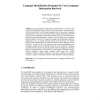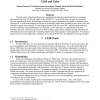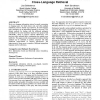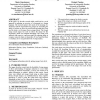CLEF
2010
Springer
14 years 5 months ago
2010
Springer
In our participation to the 2010 LogCLEF track we focused on the analysis of the European Library (TEL) logs and in particular we experimented with the identification of the natura...
TREC
2001
14 years 6 months ago
2001
The University of Maryland Researchers participated in both the Arabic-English Cross Language Information Retrieval (CLIR) and Video tracks of TREC-10. In the CLIR track, our goal...
ECIR
2004
Springer
14 years 6 months ago
2004
Springer
Cross language information retrieval is a field of study that has received significant research attention, resulting in systems that despite the errors of automatic translation (f...
CLEF
2006
Springer
14 years 8 months ago
2006
Springer
We here describe the subword approach we used in the 2006 ImageCLEF Medical Image Retrieval task. It is based on the assupmtion that neither fully inflected nor automatically stem...
CLEF
2001
Springer
14 years 9 months ago
2001
Springer
Sheffield’s contribution to the interactive cross language information retrieval track took the approach of comparing user’s abilities at judging the relevance of machine tran...
CIKM
2003
Springer
14 years 9 months ago
2003
Springer
Most cross language information retrieval research concentrates on language pairs for which direct, rich, and often multiple translation resources already exist. However, for most...
CIKM
2003
Springer
14 years 9 months ago
2003
Springer
Out of vocabulary (OOV) words are problematic for cross language information retrieval. One way to deal with OOV words when the two languages have different alphabets, is to trans...
SIGIR
2004
ACM
14 years 10 months ago
2004
ACM
In this paper, we describe research which could lead to a novel approach to gathering an overview of a document in a foreign language. The research explores how much of the meanin...
CLEF
2005
Springer
14 years 10 months ago
2005
Springer
This year, we have participated on multilingual two years on and Multi-8 merging-only CLEF task. Our main interest has been to test several usual CLIR tasks and investigate how th...
CLEF
2005
Springer
14 years 10 months ago
2005
Springer
In the CLEF 2005 Ad-Hoc Track we experimented with language-specific morphosyntactic processing and light Natural Language Processing (NLP) for the retrieval of Bulgarian, French,...




